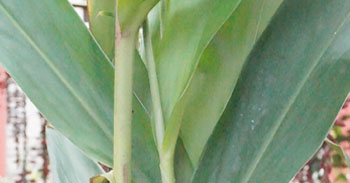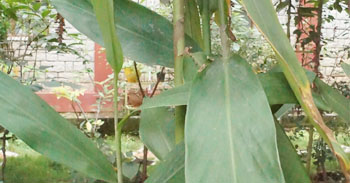KJC Medicinal Garden
Seenakachora
Hedychium spicatum
Order: Angiosperms
Family: Zingiberaceae
Genus: Hedychium
Species: H. spicatum
Common Names: Spiked ginger or Perfume ginger
Native to China [Guizhou, Yunnan, Tibet, Sichuan], The Himalayas, Myanmar, Thailand and Ethiopia
Other plants of the same genus with medicinal properties
-
Hedychium forrestii
H. spicatum
H. coronarium
H. gardnerianum
- Tall perennial herb with leafy stems and grows up to 1.5m by 0.7m
- The leaves oblong or oblong-lanceolate, reaching 30 cm or more
- Spikes sometimes 30 cm, densely flowered, bracts large, oblong, obtuse, calyx shorter than bract flower white ascending and closely imbricate type
- The flowers are hermaphrodite (has both male and female organs)
- Grows well in moist soil, sunny position and wide range of climatic conditions of forest margins from 1500 to 2800m altitude
Uses in Tradition systems of medicine
- Inflammation
- Pain
- Asthma
- Foul breath
- Vomiting
- Diarrhoea
- Bronchitis
- Hiccough
- Blood diseases.
- Generally, the rhizomes and fruits are aromatic, tonic and stimulant
- Occasionally they are nutritive.
- Some are used as food as they contain starch in large quantity while others yield an astringent and diaphoretic juice
- In the hills of Uttarakhand, rhizomes are boiled and eaten with salt,
- The rhizome is cooked to prepare chutney in Manipur.
Suggested Medicinal Properties
-
• Hair loss
• Digestive disorders like loss of appetite, indigestion, flatulence, diarrhoea, vomiting, and abdominal pain
• Respiratory problems such as in treating asthma, bronchitis, and hiccup. It also gives relief from bronchospasm and bronchial asthma
• Teeth cleansing, dental aches and caries, Mouth deodorant
• Cardiac health
• Headache
• Joint pain
• Tropical Eosinophilia
• Hiccups
• Antidiabetic activity
• Tranquilizing activity
• Antihistaminic, anti-inflammatory and ulcer protective activity
• Pediculicidal activity
• Antimicrobial activity
• Hypocholesterolemic Activity
• Antioxidant and hepatoprotective activity
• Antimalarial activity
• Cytotoxic activity
Active Phytochemicals
1. Sitosterol and its glucosides
2. Furanoid diterpene-hedychenone and 7-hydroxyhedychenone
3. Essential oils: α-pinene, β-pinene, limonene, 1,8 - cineole, 2-alkanones, linalool, camphor, linalyl acetate, β-terpineol, borneol, β-caryophyllene, γ-cadinene, humulene, terpinolene, p-cymene, benzyl cinnamate, benzyl acetate, lindylacteate, γ-terpinene, β-phellandrene, methyl paracumarin acetate, cinnamic ethyl acetate, ethyl-pmethoxycinnamate, ethyl cinnamate, d-sabinene, sesquiterpene-cadinene, sesquiterpene alcohols, sesquiterpene hydrocarbons, drimane and labdane derivatives, hedychenone, 7–hydroxyhedychenone, spicatanoic acid, spicatanol, spicatanolmethyl ether, terpinene, limonene and terpeneol
References
Kumar, A., Aswal, S., Chauhan, A., Semwal, R.B., Kumar, A., Semwal, D.K. Ethno medicinal investigation of medicinal plants of Chakrata region (Uttarakhand) used in the traditional medicine for diabetes by Jaunsari tribe. Nat. Prod. Bioprospecting. Vol. 9(2019): 175–200. doi: 10.1007/s13659-019-0202-5
Rasool, S. and Maqbool, M. An overview about Hedychium spicatum: A review, Journal of Drug Delivery and Therapeutics.Vol.9, 1-s(2019): 476-480
Sandeep R., Arun K. Jugran,Indra D. Bhatt, Ranbeer S. Rawal. Hedychium spicatum: a systematic review on traditional uses, phytochemistry, pharmacology and future prospectus. Journal of Pharmacy and Pharmacology. Vol.70, 6 (2018): 687-712.

